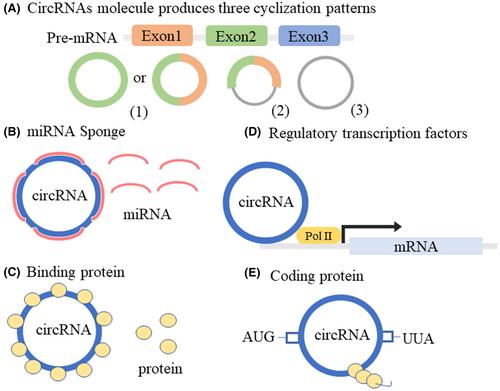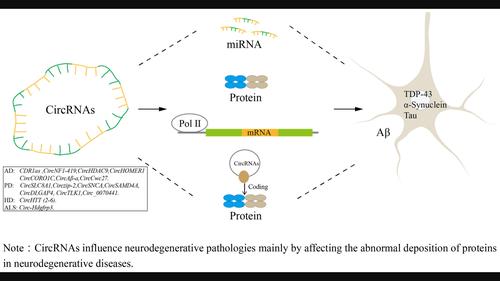Regulatory mechanism of circular RNAs in neurodegenerative diseases
Abstract
Background
Neurodegenerative disease is a collective term for a category of diseases that are caused by neuronal dysfunction, such as Alzheimer's disease (AD), Parkinson's disease (PD), and amyotrophic lateral sclerosis (ALS). Circular RNAs (circRNAs) are a class of non-coding RNAs without the 3′ cap and 5′ poly(A) and are linked by covalent bonds. CircRNAs are highly expressed in brain neurons and can regulate the pathological process of neurodegenerative diseases by affecting the levels of various deposition proteins.
Aims
This review is aiming to suggest that the majority of circRNAs influence neurodegenerative pathologies mainly by affecting the abnormal deposition of proteins in neurodegenerative diseases.
Methods
We systematically summarized the pathological features of neurodegenerative diseases and the regulatory mechanisms of circRNAs in various types of neurodegenerative diseases.
Results
Neurodegenerative disease main features include intercellular ubiquitin–proteasome system abnormalities, changes in cytoskeletal proteins, and the continuous deposition of insoluble protein fragments and inclusion bodies in the cytoplasm or nucleus, resulting in impairment of the normal physiological processes of the neuronal system. CircRNAs have multiple mechanisms, such as acting as microRNA sponges, binding to proteins, and regulating transcription. CircRNAs, which are highly stable molecules, are expected to be potential biomarkers for the pathological detection of neurodegenerative diseases such as AD and PD.
Conclusions
In this review, we describe the regulatory roles and mechanisms of circRNAs in neurodegenerative diseases and aim to employ circRNAs as biomarkers for the diagnosis and treatment of neurodegenerative diseases.



 求助内容:
求助内容: 应助结果提醒方式:
应助结果提醒方式:


